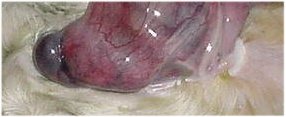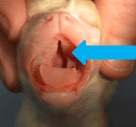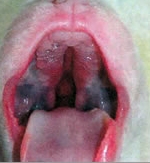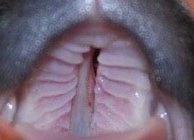|
Birth defects or
developmental anomalies in puppies
NOTE,
PHOTOS IN THESE ARTICLES MAY BE DISTURBING TO SOME PEOPLE -- THIS
PAGE IS FOR ADULTS ONLY!!!
Photos and stories
were collected from contributing breeders and will remain anonymous
. Thanks to those
who contribute, so that others can be educated. Although the majority
of breeders who contact me are Labrador breeders, this page will
not be limited to Labradors only. If the breeders of any breed
wish to contribute, they may do so.
These cases are
presented for two purposes:
1. To educate breeders
on the different birth anomalies they may encounter through the
years
2. To educate those considering breeding their dog on the hard
realities of having a litter.
Breeding dogs
is an art, and not for the faint of heart!
- (Greek for
“belly cleft”) Can
be small, with only a small amount of intestine exposed, or large, with most of the abdominal organs, including intestine,
liver, and spleen are present outside the abdominal cavity

Click for detailed images: warning - graphic!
|
As a fetus is growing, different organ systems are
developing and maturing. Early in development, the intestines actually
project into the umbilical cord as they are growing. The intestines
should return to the abdomen. When the fetus is growing and developing
during pregnancy, there is a small opening in the abdominal muscles
that the umbilical cord can pass through, connecting the mother to the
fetus. As the fetus matures, the abdominal muscles should meet in the
middle and grow together, closing off this opening. An omphalocele
occurs when the abdominal organs do not return to the abdominal cavity
as they should. |
Cleft Palate
  
Exposure to toxins or
infectious diseases
during the 25th to 28th day of pregnancy may also induce cleft
palates.
Administration
of cortisone during pregnancy can lead to the development of cleft
palate in the fetus
Administration
of the cytotoxic drug hydroxyurea (hydroxycarbamide) is reported
to cause cleft palate.
-
- Failure of the two
sides of the palate to fuse correctly during the embryonic stage of
developement. It can just be the soft tissue, in which case it is only
cosmetic defect, but if the hard palate is affected, a puppy usually
dies. Affected puppies have difficulty nursing and do poorly.
- Symptoms:
- Can't suckle
properly
- Have a slight
quacking sound to their "voice".
- Smack while
trying to nurse
- Milk comes out of
nose while nursing on mother
- When tested on
the finger, the puppy tends to chew, rather than suck.
- opening in roof
of mouth detected. Often not associated with cleft lip.
-
- Puppies are often
euthanized. They can be tube fed, and hand raised, until they're old
enough to have surgery, but this is difficult on both the owner and the
puppy. Each breeder must make their own decisions.
-
- A cleft palate can
be corrected surgically, however the puppy must be old enough to
undergo an anesthesia.
- Centronuclear Myopathy (while
not a birth defect in the sense of a deformity, the actions of this
disease can be seen at an early age in the life of a puppy)
- Fading Puppy Syndrome (click
here for article)
- Genital Anomalies
- Leg and foot deformities:
- Tongue
Anomalies:
 Macroglossia, or
large tongue, sometimes
resolves with age and would not be clinically significant. Degrees
of Macroglossa could result in excessive drooling, tongue injury,
or excessively dry tongue. Macroglossia, or
large tongue, sometimes
resolves with age and would not be clinically significant. Degrees
of Macroglossa could result in excessive drooling, tongue injury,
or excessively dry tongue.
Accounts from breeders without
photos:
I had a puppy born
with its umbilicus in
its chest, rather than its abdomen. A very large diaphragmatic
hernia was suspected. The cord was very wide at the base, and
there was a pulsating (heart?) at the base of the cord, as well
as a rise and fall within the cord with respiration. The puppy
was euthanized shortly after birth.
This page
is dedicated to the puppies who taught us so much in the short
time they lived.
Something to
Remember about Breeders
Author Unknown
How many
litters does a breeder have to have before being considered an
experienced breeder?
They should
have bred at least one good litter that they can brag on. This
will gain them credibility.
They should
have had at least one litter that looked great on paper but turned
out to be a disaster. This will teach humility.
They should
have held (God forbid!) at least one deformed puppy and wept as
it slipped into the calm, silent quiet of death. This will provide
the heart to be very careful to do everything possible to not
see it again.
They should
have studied the lines and the traits and the greats and the problems
each has produced and read all the books they can bet their hands
on. This will give them knowledge.
Last of
all, they should have consulted the greats in the breed and never,
never consider themselves to be experienced breeders. They are
then, possibly, experienced breeders.
|

